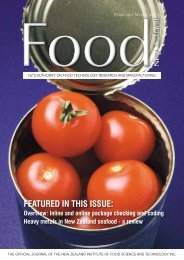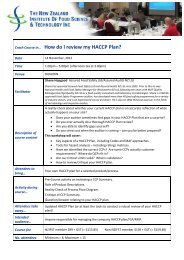featured in this issue - NZIFST - The New Zealand Institute of Food ...
featured in this issue - NZIFST - The New Zealand Institute of Food ...
featured in this issue - NZIFST - The New Zealand Institute of Food ...
Create successful ePaper yourself
Turn your PDF publications into a flip-book with our unique Google optimized e-Paper software.
y Spr<strong>in</strong>ger. This is exactly what Mouritsen achieves with his<br />
book. <strong>The</strong> reader ga<strong>in</strong>s <strong>in</strong>sight <strong>in</strong>to the deeper implications and<br />
the fasc<strong>in</strong>at<strong>in</strong>g questions <strong>in</strong>volved.<br />
<strong>The</strong> field <strong>of</strong> lipid research is central to essential aspects <strong>of</strong><br />
life; its orig<strong>in</strong>, its metabolic regulation, the bra<strong>in</strong>, and decays <strong>in</strong><br />
various forms. Traditional approaches to lipid research through<br />
physics, chemistry, biology, and medic<strong>in</strong>e are complemented<br />
by nanotechnology, high throughput technologies, etc., and are<br />
now rapidly evolv<strong>in</strong>g <strong>in</strong>to a multidiscipl<strong>in</strong>ary science, the lipidomics<br />
enterprise.<br />
For lipids, it is the third <strong>in</strong> a row <strong>of</strong> “omics”, after genomics<br />
and proteomics, that strives to put the “heap <strong>of</strong> stones <strong>in</strong>to<br />
the shape <strong>of</strong> a house” (Po<strong>in</strong>tcare). As Mouritsen puts it: a new<br />
lipidomics science has to go beyond the mapp<strong>in</strong>g <strong>of</strong> all lipid<br />
species <strong>in</strong> all cell types and must approach cellular function<strong>in</strong>g<br />
from a more holistic perspective. <strong>The</strong> present state <strong>of</strong> affairs is<br />
still largely such that the answers are there, but what are the<br />
questions This book is a plea for hypothesis-driven science<br />
that has to follow the undoubtedly necessary efforts <strong>of</strong> stamp<br />
collection.<br />
In that sense, the book is wonderfully excit<strong>in</strong>g to read. It is<br />
structured <strong>in</strong>to three parts: the first part (<strong>The</strong> Overlooked Molecules)<br />
describes <strong>in</strong> seven chapters the molecules, their chemistry<br />
and physics, and <strong>in</strong>troduces the concept <strong>of</strong> larger shape<br />
creation through self-assembly. It ends with a six-page essay<br />
on ‘Models and Fashion’. As with all complex systems, models<br />
are important as nuclei for structured debate. With biological<br />
membranes - where the enormous breadth <strong>of</strong> scales <strong>in</strong> sizes<br />
(from Angstroms to millimetres) and <strong>in</strong> times (from picoseconds<br />
to days) exceeds normal imag<strong>in</strong>ation - <strong>this</strong> structur<strong>in</strong>g power<br />
<strong>of</strong> models is <strong>of</strong> particular importance. Mouritsen gives a lucid<br />
critique on the exist<strong>in</strong>g membrane models.<br />
Remarkably, <strong>this</strong> chapter does not conta<strong>in</strong> the fashionable<br />
“rafts”, which are found <strong>in</strong> almost every self-important publication<br />
on membrane biophysics <strong>of</strong> today, but have not yet been<br />
seen <strong>in</strong> reality. No fear, however, rafts do appear <strong>in</strong> the follow<strong>in</strong>g<br />
part.<br />
<strong>The</strong> second part (Lipids Make Sense) is devoted to the structural<br />
and dynamic organisation <strong>of</strong> lipids at the supramolecular<br />
level. It covers the ‘phase’ aspect with all its associated phenomena,<br />
such as transitions, separations, fluctuations, also ‘rafts’,<br />
and <strong>in</strong>teractions, arriv<strong>in</strong>g f<strong>in</strong>ally at the <strong>in</strong>teraction with prote<strong>in</strong>s.<br />
This part <strong>in</strong>deed covers a selection <strong>of</strong> relevant concepts and essential<br />
phenomena without gett<strong>in</strong>g <strong>in</strong>to the maze <strong>of</strong> too many<br />
experimental results.<br />
<strong>The</strong> third part focuses on function (Lipids <strong>in</strong> Action). Cholesterol<br />
makes the start, as it does <strong>in</strong> the history <strong>of</strong> lipid science.<br />
This is followed by a brief chapter on how lipids match up with<br />
prote<strong>in</strong>s - the mattress model and hydrophobic mismatch concept,<br />
among others. <strong>The</strong>n the text shifts to nutritional aspects<br />
<strong>of</strong> essential fatty acids, and how a physicist can rationalise such<br />
diverse phenomena <strong>of</strong> life, as e.g. anaesthesia, obesity, and apoptosis.<br />
‘Smart nanotechnology’ stands at the end <strong>of</strong> <strong>this</strong> selection<br />
<strong>of</strong> examples.<br />
A whole legion <strong>of</strong> scientific texts on membranes and lipids<br />
have appeared over the past five decades, start<strong>in</strong>g with the<br />
classics <strong>of</strong> Dennis Chapman <strong>in</strong> the late Sixties, some more and<br />
some less memorable. This book <strong>of</strong> Mouritsen’s is different <strong>in</strong><br />
be<strong>in</strong>g very readable, stimulat<strong>in</strong>g and concise. Perhaps not un<strong>in</strong>tentionally,<br />
its rather decent, unassum<strong>in</strong>g layout - no glossy<br />
charts and pictures, no flashy highlights or boxes - supports its<br />
impression on the reader who wants to be seriously <strong>in</strong>formed<br />
<strong>of</strong> current ideas and concepts, rather than be carried away with<br />
facts and figures. It will be an excellent companion for lipidologists,<br />
membranologists and lipidomiacs at all levels <strong>of</strong> expertise<br />
for time to come. It can be particularly recommended as a text<br />
for <strong>in</strong>terdiscipl<strong>in</strong>ary university courses <strong>in</strong> life sciences.<br />
Andrew McKenzie<br />
Chief<br />
Executive<br />
NZ <strong>Food</strong> Safety<br />
Authority<br />
Good Operat<strong>in</strong>g Practice - guidance ready to pilot<br />
Under the proposed food regulatory system most food<br />
bus<strong>in</strong>ess operators will need to have a risk management<br />
tool such as a <strong>Food</strong> Control Plan (FCP) <strong>in</strong> place. This will<br />
document how they manage their bus<strong>in</strong>ess to ensure they<br />
produce safe and suitable food.<br />
In previous columns I’ve talked about the voluntary implementation<br />
<strong>of</strong> ‘<strong>of</strong>f-the peg’ FCPs that has been rolled out<br />
<strong>in</strong> most parts <strong>of</strong> the country s<strong>in</strong>ce July 2008. This is be<strong>in</strong>g<br />
done <strong>in</strong> anticipation <strong>of</strong> a new <strong>Food</strong> Act, so that we can<br />
make the most <strong>of</strong> the impetus created by the considerable<br />
amount <strong>of</strong> work that’s already gone <strong>in</strong>to develop<strong>in</strong>g the<br />
new food regulatory system.<br />
An <strong>of</strong>f-the-peg FCP is a ready-to-use plan, developed by<br />
NZFSA for food sectors where processes are similar across<br />
that sector. Custom-made FCPs will need to be created by<br />
operators <strong>of</strong> bus<strong>in</strong>esses that are more complex, or have<br />
unique or commercially confidential practices, to suit their<br />
particular process. <strong>The</strong>y may be developed from scratch,<br />
or adapted from one or more <strong>of</strong> the <strong>of</strong>f-the-peg FCPs as<br />
appropriate.<br />
Good Operat<strong>in</strong>g Practice (GOP) procedures cover<strong>in</strong>g<br />
both food safety and suitability are the basic build<strong>in</strong>g<br />
blocks <strong>in</strong> prepar<strong>in</strong>g a custom-made FCP. <strong>The</strong> procedures<br />
<strong>in</strong>corporate good hygienic practice and good agricultural<br />
practice/good manufactur<strong>in</strong>g practice that are currently <strong>in</strong><br />
use by <strong>in</strong>dustry. We expect hazard analysis and critical control<br />
po<strong>in</strong>t (HACCP) pr<strong>in</strong>ciples for food safety to be applied<br />
after the good operat<strong>in</strong>g practice components <strong>of</strong> the FCP<br />
are <strong>in</strong> place.<br />
NZFSA has released for comment draft guidance for<br />
bus<strong>in</strong>esses to develop their own good operat<strong>in</strong>g practice<br />
procedures, such as allergen management, clean<strong>in</strong>g and<br />
sanitation, product <strong>in</strong>formation, and pest control - as relevant<br />
to the bus<strong>in</strong>ess.<br />
Each guidance document prompts the food bus<strong>in</strong>ess<br />
operator on what they need to consider for effective hazard<br />
management.<br />
<strong>The</strong> draft guidance <strong>in</strong>formation is available to download<br />
from NZFSA’s website <strong>this</strong> month and operators have four<br />
months to review the <strong>in</strong>formation, trial it if they wish, and<br />
comment to NZFSA on its usefulness.<br />
NZFSA would be keen for food bus<strong>in</strong>ess operators to<br />
apply the draft guidance material to their bus<strong>in</strong>ess as appropriate<br />
over the next few months and let us know what<br />
worked well and what didn’t. NZFSA <strong>in</strong>vites comments<br />
from anyone, whether you represent a bus<strong>in</strong>ess or are act<strong>in</strong>g<br />
as an <strong>in</strong>dividual.<br />
You can download the draft guidance <strong>in</strong>formation and<br />
f<strong>in</strong>d out more about the proposed FCP manual from our<br />
website (www.nzfsa.govt.nz). Follow the green <strong>Food</strong> Control<br />
Plan l<strong>in</strong>k on the front page.<br />
Please email your response by 30 June 2009 to<br />
tss@nzfsa.govt.nz or send it to:<br />
Suzie McQuoid<br />
Adviser (Technical Standards & Systems)<br />
<strong>New</strong> <strong>Zealand</strong> <strong>Food</strong> Safety Authority<br />
PO Box 2835<br />
Well<strong>in</strong>gton 6140<br />
www.nzfsa.govt.nz<br />
OILS & FATS<br />
February/March 2009<br />
23

















